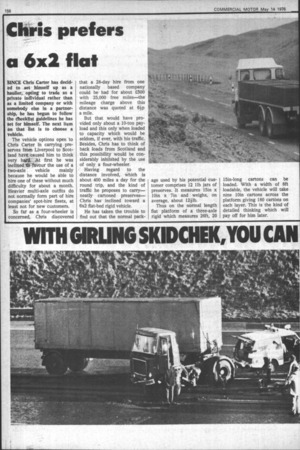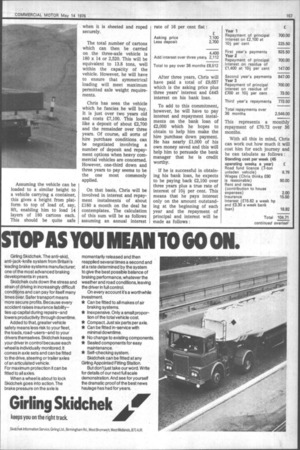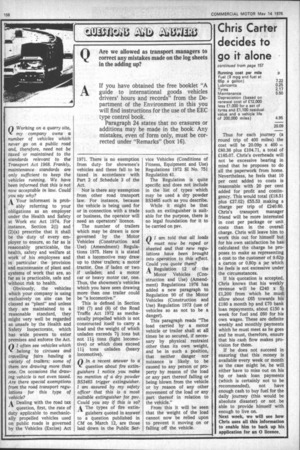Chris prefers a 6x2 flat
Page 158

Page 159

Page 160

If you've noticed an error in this article please click here to report it so we can fix it.
SINCE Chris Carter has decided to set himself up as a haulier, opting to trade as a private individual rather than as a limited company or with somebody else in a partnership, he has begun to follow the Checklist guidelines he has set for himself. The next item on that list is to choose a vehicle.
The vehicle options open to Chris Carter in carrying preserves from Liverpool to Scotland have caused him to think very hard. At first he was Inclined to favour the use of a two-axle vehicle mainly because he would be able to hire one of these without much difficulty for about a month. Heavier multi-axle outfits do not normally form part of hire companies' spot-hire fleets, at least not for new customers.
So far as a four-wheeler is concerned, Chris discovered that a 28-day hire from one nationally based company could be had for about £500 with 25,000 free miles—the mileage charge above this distance was quoted at 60 a mile.
But that would have provided only about a 10-ton payload and this only when loaded to capacity which would be seldom, if ever, with his traffic. Besides, Chris has to think of back loads from Scotland and this possibility would be considerably inhibited by the use of only a four-wheeler.
Having regard to the distance involved, which is about 400 miles a day for the round trip, and the kind of traffic he proposes to carry— neatly cartoned preserves— Chris has inclined toward a 6x2 flat-bed rigid vehicle.
He has taken the trouble to find out that the normal pack age used by his potential customer comprises 12 llb jars of preserves. It measures 15in x 10in x 7in and weighs, on average, about 121b.
Thus on the normal length flat platform of a three-axle rigid which measures 26ft, 20 15in-long cartons can be loaded. With a width of 8ft loadable, the vehicle will take nine 10in cartons across the platform giving 180 cartons on each layer. This is the kind of detailed thinking which will pay off for him later.
Assuming the vehicle can be loaded to a similar height to a vehicle carrying a container, this gives a height from plat form to top of load of, say, 8ft, enabling him to load 14 layers of 180 cartons each.
This should be quite safe when it is sheeted and roped securely.
The total number of cartons
which can then be carried
on the three-axle vehicle is 180 x 14 or 2,520. This will be equivalent to 13.8 tons, well within the capacity of the vehicle. However, he will have to ensure that symmetrical loading will meet maximum permitted axle weight requirements.
Chris has seen the vehicle which he fancies he will buy. It is just over two years old
and costs £7,100. This looks like a deposit of about £2,700 and the remainder over three years. Of course, all sorts of hire purchase conditions can be negotiated involving a number of deposit and repayment options when heavy cornmercial vehicles are concerned, However, one-third down and three years to pay seems to be the one most commonly applied, On that basis, Chris will be involved in interest and repay ment instalments of about £180 a month on the deal he contemplates. The calculation of this sum will be as follows assuming an annual interest rate of 16 per cent flat :
Asking price ,7,,1,„,00
4 Less deposit '/VU 4,400 Add interest over three years 2,112 Total to pay over 36 months £6,512
After three years, Chris will have paid a total of £9,657 which is the asking price plus three years' interest and £445 interest on his bank loan.
To add to this commitment, however, he will have to pay interest and repayment instal ments on the bank loan of £2,000 which he hopes to obtain to help him make the hire purchase down payment.
He has nearly £1,000 of his own money saved and this will help him to persuade the bank
manager that he is credit worthy.
If he is successful in obtaining his bank loan, he expects to be paying back £2,100 over three years plus a true rate of interest of 10/ per cent. This means that he pays interest only on the amount outstanding at the beginning of each year and the repayment of principal and interest will be made as follows :
Year 1
Repayment of principal 700.00 Interest on £2,100 at 101 per cent 225.50
First year's payments 925.50 Year 2
Repayment of principal 700.00
Interest on residue of £1,400 at 10-2 per cent 147.00
Second year's payments 847.00
YRear 3 m ent of principal 700,00 Interest on residue of £700 at 10-1 per cent 73.50
Third year's repayments 773.50 Total repayments over 36 months 2,546.00
This represents a monthly repayment of £70.72 over 36 months.
With all this in mind, Chris can work out how much it will cost him for each journey and he can tabulate as follows :
Standing cost per week (45 operating weeks a year) £
Road fund licence (7-ton
unladen vehicle) 8.79 Wages (Chris thinks £60
is reasonable) 50.00 Rent and rates
(contribution to house expenses) 2.00 Insurance 15.00
I ntderEe3st3 (£15.6e2ekabwaneiek hp alonan) 6 a w 18.92 Running cost per mile
Fuel (9 mpg and fuel at
65p a gallon) 7.22 Lubricants 0.25 Tyres 2.17 Maintenance 550
Depreciation (based on renewal cost of £12,000 less £1,000 for a set of tyres and £1,100 residual value and a vehicle life
of 200,000 miles) 4.95
20.09 Thus for each journey (a round trip of 400 miles) the cost will be 20.09p x 400 -_,_ £80.36 plus £104.71, a total of £185.07. Chris's overheads will not be excessive bearing in mind that he proposes to do all the paperwork from home. Nevertheless, he feels that 10 per cent added to costs is reasonable with 20 per cent added for profit and contingency. This would total (£18.51 plus £37.02) £55.53 making a charge per trip of £240.60. Chris's transport manager friend will be more interested in cost per package or unit, costs than in the overall charge. Chris will leave him to work this out for himself but for his own satisfaction he has calculated the charge he proposes to make as representing a cost to the customer of 9.62p a carton or 0.80p a jar which he feels is not excessive under the circumstances.
If his quotation is accepted, Chris knows that his weekly revenue will be £240 x 5) £1,200 from which he must allow about £65 towards his £180 a month hp and £70 bank loan repayments, about £150 a week for fuel and £60 for his own wages. These are definite weekly and monthly payments which he must meet as he goes and he must, therefore, ensure that his cash flow makes pro vision for them.
If he does not succeed in ensuring that this money is available every week or month as the case might be, he will either have to miss out on his hp or bank loan payments (which is certainly not to be recommended), not have enough cash to buy fuel for the daily journey (this would be absolute disaster) or not be able to provide himself with enough to live on.
Next week, we will see how Chris uses all this information to enable him to back up his application for an 0 licence,




























































































































































































































